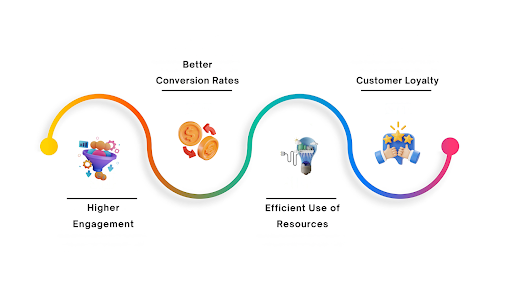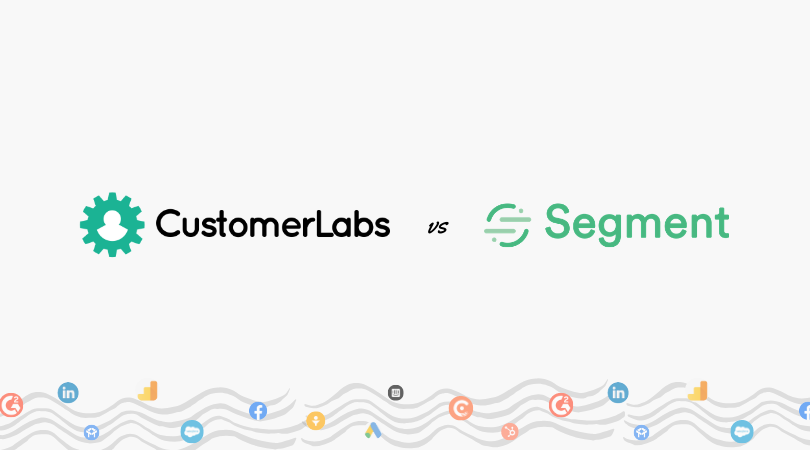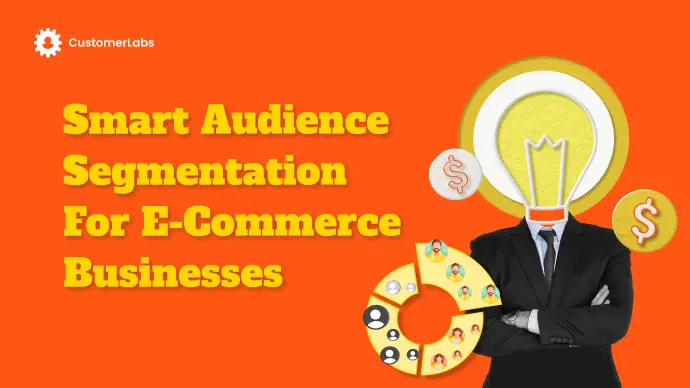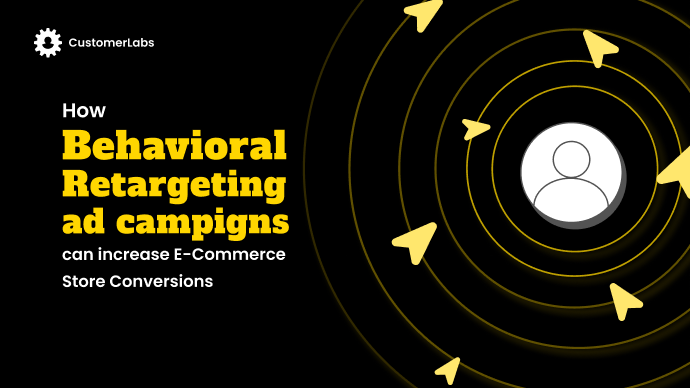Imagine you’re running a marketing campaign, but your results aren’t what you expected. You’re targeting a wide audience, but conversions are low, and engagement is dropping. You’re left wondering—how can you improve your marketing efforts? The answer lies in user segmentation.
If you do segmentation the right way, you’ll get the expected results. But if you don’t do it right, the results could be catastrophic.
If you don’t know your audience, you risk launching a campaign that flops. Or, you could read this guide, understand user segmentation, and avoid that situation.
What is User Segmentation?
User segmentation divides a broad audience into smaller, more specific groups based on shared characteristics. These characteristics include demographics, behaviors, geographic location, psychographics, technology use, and more. When you segment your users, you better understand each group’s needs and preferences. This allows you to tailor your marketing efforts, products, or services to their needs.
Wondering why put so much effort into user segmentation? Here’s why:
- If you make segments of your users, you can make your marketing and customer engagement more effective and targeted.
- Every customer is different, and trying to appeal to everyone with the same message rarely works. If you segment your users into groups based on different traits, you’ll have a clear idea of what to say and whom to say it.
- Segmentation allows you to create personalized marketing strategies that resonate with each segment, which can lead to increased conversions and customer retention.
- It saves you from wasted marketing effort, money, and time. For example, you have both premium product seekers and budget-conscious buyers; hence, offering a discount coupon might work for the latter, but a premium product seeker won’t buy it.
- You’re up against high competition and the short attention span of customers. Presenting a generalized message or product will put you on the back.
Companies like Amazon and Netflix understand this and offer highly personalized recommendations to their users. Now you get why there’s a “Since you’ve watched” section on Netflix!
General Benefits of User Segmentation

Segmentation offers several key benefits:
- Higher Engagement: Personalized messages that address a segment’s specific needs capture attention and prompt action.
- Better Conversion Rates: Tailored offers make users feel valued, increasing the chances of conversion.
- Efficient Use of Resources: Focused targeting ensures marketing spend reaches those most likely to engage.
- Customer Loyalty: A personalized experience fosters stronger customer relationships, leading to repeat business.
Most Common Types of User Segmentation
Now that we’ve covered what is user segmentation and its importance, let’s explore how you can segment your audience. Moving forward, we will discuss user segmentation based on users’ behaviors or interactions, demographics, geography, psychographics, technographics, and firmographics. Each type of segmentation focuses on specific aspects, and by using these audience segmentation strategies, you can unleash personalized and targeted marketing.
Let’s begin with behavioral segmentation, which is particularly useful for marketers like you.
Behavioral Segmentation
Behavioral segmentation divides your audience based on how they interact with your product or service. Instead of focusing on who your users are, it looks at what they do. This includes adding items to the cart, starting the checkout process, viewing product pricing pages among others. These behaviors help identify high-intent users, abandoned carts, or users who are just browsing.
Further, you can also create separate segments for customers who leave your website after adding items to the cart, those who just browse without making a purchase, or users who exhibit a variety of other behaviors.
Behavioral segmentation offers endless possibilities for improving your performance marketing efforts. You can group users based on a wide range of actions and behaviors, making it easier to create personalized campaigns that drive results. Here are a few examples:
1. Abandoned Cart
Identify users who added products to their cart but didn’t complete the purchase. These users are high-potential leads, and retargeting them with personalized offers can recover lost sales.
Example: You can segment users who added the red dress to their cart but didn’t complete the checkout and send them a personalized email offering a discount or free shipping to entice them to finish the purchase.
2. Checkout Initiated but Not Purchased
Segment users who started the checkout process but didn’t complete it. These users show strong buying intent and can be targeted with limited-time offers or reminders to boost conversions.
Example: If a user started the checkout for a pair of sneakers but didn’t finish, you could send them a reminder with an exclusive offer that expires soon to encourage them to complete the purchase.
3. High-Order Value Purchasers
Focus on your top customers by segmenting those who make high-value purchases. You can push these segments into lookalike campaigns to find similar high-value users or retarget them with upsell and cross-sell offers to increase lifetime value.
Example: Target users with an average order value (AOV) above a certain threshold and create lookalike audiences for more precise ad targeting on platforms like Facebook and Google Ads.
4. Product-Viewed but Not Added to Cart
Segment users who visited specific product pages but didn’t take the next step of adding to the cart. By understanding what they viewed, you can retarget them with ads or emails showcasing reviews, benefits, or special promotions.
Example: If a user viewed a blue leather jacket but didn’t add it to their cart, you can send them an email highlighting positive customer reviews or suggest similar jackets that are currently on sale.
5. Specific Page Views
Track users who visit high-intent pages like pricing or solution pages. These users are closer to conversion and can be retargeted with relevant ads to push them further down the funnel.
You can also track visitors who browse specific category pages or product collections. By understanding which categories or products they are interested in, you can retarget them with ads or emails highlighting similar products, promotions, or customer reviews to encourage them to make a purchase.
Example: If a user visits your subscription plan page but doesn’t sign up, you can send them a targeted ad or email offering a special discount on the first month to encourage them to take action.
6. Full-Funnel Behavior Segmentation
Segment your audience based on where they are in the funnel—whether they’re in the awareness stage or ready to purchase—and create personalized campaigns that guide them through each stage. For example, users who have browsed multiple product categories but haven’t made a decision yet could be shown a tailored ad comparing popular products, while those closer to purchase can be targeted with limited-time offers.
This is just an example of how you can segment your users based on their behavior. As user behavior is complex, there are numerous ways to group them by their actions.
Hence, to effectively implement behavioral segmentation, you need the right tools to track and analyze user interactions collected from your first-party data. You might want to consider:
- Google Analytics provides insights into how users navigate your website, showing metrics like session duration, pages visited, and conversion rates.
- Mixpanel tracks specific user actions, like how often a feature is used, helping you understand which parts of your product drive engagement.
- Hotjar focuses on user experience by offering heatmaps and session recordings, revealing where users are getting stuck or dropping off.
- CustomerLabs helps marketers create powerful behavioral segments, like abandoned carts or product views, and even more complex segments involving multiple user actions. With CustomerLabs, you can segment audiences based on key behaviors or build custom, dynamic segments and sync them with ad platforms and marketing platforms like Meta Ads, Klaviyo, etc., to enhance your marketing campaigns.
| “Around 97% of visitors who land on a website for the first time don’t return, so it’s crucial to re-engage them with appealing offers that draw them back.”Source: Qualtrics |
Demographic Segmentation
Demographic segmentation is a straightforward way to divide your audience. It includes traits such as age, gender, education level, income, occupation, and marital status. These traits might seem basic on the surface, but they influence the purchasing behavior of the users.
Let’s say you’re promoting a supplement brand through targeted ads. If you show a 24-year-old man who has a steady income source an expensive but high-performance pre-workout supplement, he might buy it. But do the same to a 55-year-old man with an arthritis problem, and he won’t even bother taking a look at your ad. Let’s discuss it in more detail with use cases:
Retail
E-commerce sites can recommend products based on gender and age. For example, Nike uses demographic segmentation to target customers aged 15 to 45, featuring athletes and influencers in their campaigns that resonate with this group.
Travel
A travel agency can offer honeymoon packages to married couples while promoting solo trips to singles. For example, Expedia uses performance marketing to target users based on their search history and preferences. They might show honeymoon packages to couples researching romantic getaways while promoting adventure trips to solo travelers looking for unique experiences.
Education
Online learning platforms can suggest advanced courses to users with a higher education level and beginner courses to those without a degree. For example, Coursera uses demographic segmentation to offer beginner-level courses to users early in their careers while showing specialized programs, like data science certifications, to professionals looking to upskill.
Segmentation Across Marketing Channels
A fashion retailer might send birthday discounts to younger customers and exclusive deals to older customers based on purchasing power. For example, Adidas uses demographic segmentation to tailor their marketing campaigns across different channels. For younger, trend-focused buyers, they might send personalized emails featuring limited-edition sneakers, while targeting older, more affluent customers with ads or social media posts promoting high-performance gear.
Businesses use tools like Google Analytics to make demographic segmentation easy. Google Analytics helps track key data like age, gender, and location, giving insights into user behavior. You can see which groups engage most and tailor content accordingly.
Once you’ve segmented users based on measurable traits like age, income, and occupation, you can take it a step further by applying this segmentation across multiple marketing channels.
For example:
- Email Marketing: You might send targeted newsletters to different age groups or purchasing power segments, offering deals and content relevant to each.
- Social Media: Platforms like Facebook and Instagram offer demographic-based targeting, so you can show ads for specific products to users based on their location, gender, or interests.
- Paid Ads: Google Ads and other PPC platforms allow you to refine your targeting even more, showing personalized offers or products to users with specific demographic traits.
Segmentation across marketing channels opens up endless opportunities to deliver personalized content at every touchpoint, making sure that your audience receives relevant messaging, no matter where they engage with your brand.
Alright, we have divided the users based on measurable traits like age, income, and occupation. What’s next? Let’s take it one more level deeper.
Geographic Segmentation
Geographic segmentation divides your audience based on their location, which could range from broad categories like continent or country to more specific areas like region, city, or even neighborhood. Understanding where your users are located helps you tailor your marketing efforts to fit each area’s cultural, climatic, and economic conditions of each area.
| “Research indicates that 90% of marketers believe location-based marketing enhances sales. By delivering tailored messages relevant to specific locations, businesses can foster stronger relationships with customers, leading to increased purchases.” Source: Martech |
Take, for example, you’re promoting your global clothing brand on Facebook through ads, and you’re targeting people in the United States. While targeting people in warm states like Texas, Louisiana, Florida, and Hawaii, you can show ads for T-shirts and other summer wear. And, while targeting people who live in Alaska, North Dakota, and Minnesota, you can promote winter wear.
This segmentation is beneficial for not only businesses that serve global markets but also for local businesses. You can target a specific regional audience to achieve effective results instead of wasting efforts and resources in targeting the whole country. A product or service that performs well in one location might not work as effectively in another due to cultural differences, climate, or local preferences. By breaking down your audience by geography, you can ensure that your offers, messaging, and pricing align with the local context.
Let’s see where you can use the geographic segmentation:
- Regional Advertising: You can run targeted ads for users in specific cities or regions.
- Compliance with Local Laws: Geographic segmentation will help you follow local laws, like European GDPR or specific tax regulations in different countries.
- Seasonal Campaigns: Seasonal promotions can vary depending on the hemisphere or climate, like offering summer sales in one region while focusing on winter discounts in another.
Psychographic Segmentation
User segmentation goes a layer deeper when you divide your audience based on their psychography.
| “70% of marketers use market segmentation, with psychographic segmentation being the most effective for B2B businesses.” Source: Notify Visitors |
Pyschography digs deeper into people’s buying decisions, understanding why they buy what they buy. In psychographic segmentation, the audience is divided on the basis of interest, values, lifestyle choices, personality, and social status.
For example, let’s say you’re running Facebook ads for two users who earn $100k and are in their mid-30s. One user spends time watching tech reviews and is into high-end gadgets. The other is focused on fitness and follows health influencers. If you show an ad for the latest fitness tracker to the tech enthusiast, you’re likely wasting your budget. But, by using psychographic data, you could target the tech user with a campaign for the newest smart home device, while showing the fitness user a different ad tailored to their interests.
Conducting User Interviews for data collection
You might wonder, “How would anyone get the psychographic information?” The best way would be through zero-party data—data that customers willingly share with you. This includes surveys, interviews, and forms where users actively provide insights about their preferences and behaviors.
Zero-party data is incredibly valuable because it’s straight from the source, ensuring accuracy and relevance. For example, by conducting user interviews or surveys, you can gain detailed insights into customer lifestyles, values, interests, and buying motivations. These personal details help you create hyper-targeted marketing strategies, which are far more effective than general demographic-based approaches.
In user interviews, you can ask the users about:
- Lifestyle
- Values and beliefs
- Interests
- Buying behavior and motivation-based questions
- Aspiration and goals
- Challenges and pain points
- Desires
Psychographic segmentation has powerful applications in targeted marketing and product personalization. For example:
- A fashion brand could target users who value sustainability with eco-friendly clothing collections.
- An electronics company could promote high-end gadgets to tech enthusiasts, offering budget-conscious users more affordable, practical options.
Technographic Segmentation
Mobile users face different problems during online shopping than desktop users. People who use the Safari browser face more bugs and technical issues while using a SaaS-based product than Chrome. This calls for separate segmentation. Hence, Technographic Segmentation.
| “79% of U.S. smartphone users purchased something online through their mobile phone in the last year.” Source: Pew Research |
In technographic segmentation, you create different groups of users based on devices, software, browsers, and operating systems they use. It will help you understand how users interact with your website or app. Based on this, you can make better changes in your funnel and boost your ad’s performance. Here’s how:
- Targeted Advertising: Create device-specific ads tailored to user preferences and behaviors on different platforms, like offering app features or promotions that align with the interests and usage patterns of both iOS and Android users for better engagement.
Firmographic Segmentation
Firmographic segmentation is just like demographic user segmentation, but only for B2B businesses. Organizations can identify traits like size, niche, revenue, number of employees, and location of their target organizations and create different unique segments.
Creating firmographic segments allows businesses to create relevant offers and targeting.
Let’s say you’re running a B2B marketing campaign targeting companies across multiple industries. You’ve identified two key segments:
- Small Retail Stores (10-50 employees)
- Large Tech Enterprises (500+ employees)
With firmographic segmentation, you can tailor your campaigns accordingly. For small retail stores, your ads could highlight budget-friendly solutions, quick setup, and customer support. For large tech enterprises, you focus on scalability, integration with existing tools, and enterprise-level security.
By creating custom messaging and offers for each segment, your campaigns become far more relevant, increasing the chances of engagement and conversions. This method ensures you’re not just targeting “companies” but crafting offers that align directly with their firmographic traits.
You might be thinking “How would I know the size, employee count, revenue of a company?” To get information about size, industry, or similar firmographic information, you can use tools like Pendo. It tracks user interactions and provides insights that can be used for personalized onboarding, product recommendations, or targeted marketing campaigns. It tracks user interactions and provides insights that can be used for personalized onboarding, product recommendations, or targeted marketing campaigns.
Now that we’ve discussed various segmentation methods, the next question is how to implement these efficiently. That’s where CustomerLabs’ Nucleus Audience Builder comes into play. We make creating hyper-personalized audience segments seamless using first-party data. Whether it’s behavioral segmentation, targeting high-intent users, or re-engaging cart abandoners, CustomerLabs empowers you to manage complex audience segments effortlessly.
Conclusion
Segmentation isn’t just a fancy term; it’s your secret weapon for hitting the marketing bullseye. By really understanding who your customers are—whether it’s their shopping habits, preferences, or even the time they like to browse—you get to ditch the guesswork. No more hoping your ads reach the right people. Instead, you’ll create campaigns that speak directly to your audience’s needs, desires, and frustrations. Imagine knowing exactly when someone’s ready to purchase or when they’re just exploring—that’s the clarity segmentation brings. It’s not about throwing out random offers but giving your customers something they want. And the best part? It’s not rocket science. In today’s world, where every click counts, understanding your audience on this level can make or break your business.
At CustomerLabs, we make segmentation simple and effective, helping you to create precise audience segments with first-party data. Our platform enables you to deliver personalized messages that resonate while ensuring user privacy. With our intuitive tools, you can fine-tune campaigns, boost engagement, and scale your growth effortlessly.
Ready to take your marketing to the next level? Book a demo with us today and see how smarter segmentation can transform your results.






